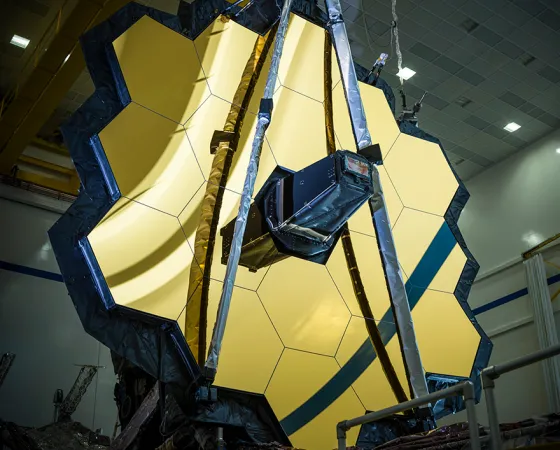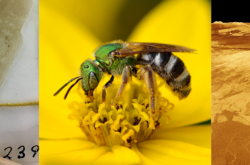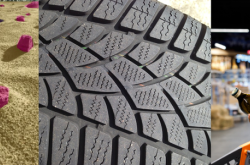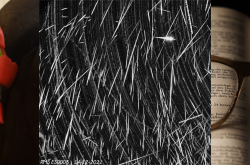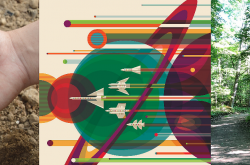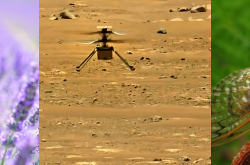The James Webb Space Telescope: A powerful new space observatory
The largest and most powerful space observatory ever built is set to launch into space on December 24, 2021, and Canada has a key role in its mission.
The James Webb Space Telescope is an incredibly complex infrared telescope which will allow us to see deeper into the Universe, to view stars and galaxies never before seen, and to discover new worlds!
To learn more about the telescope’s mission, Dr. Cassandra Marion, Science Advisor for the Canada Aviation and Space Museum, reached out to a Canadian expert. Dr. Nathalie Ouellette is an astrophysicist and the Canadian Outreach Scientist for the James Webb Space Telescope, in collaboration with the Canadian Space Agency. Through three short videos, Dr. Ouellette shares some insights about the new telescope. Watch below as she talks about the significance of this mission:
Transcript
| Audio | Visual |
|---|---|
| What is the James Webb Space Telescope and what is its mission? | The presenter, Cassandra Marion, is seated. Her head and upper torso are visible; she is wearing a navy-blue blouse. Behind her is an image of the main entrance of the Canada Aviation and Space Museum and a Canadian flag. She remains stationary throughout the video. |
| So the James Webb Space Telescope; we often describe it as the successor — not replacement — of the Hubble Space Telescope that many people know and love. It's going to be the next big space observatory that will be launched in space, led by NASA, the Canadian Space Agency, and the European Space Agency and it's going to have lots of different scientific missions, including: exploring exoplanets, maybe finding signs of life, studying the first galaxies ever created after the big bang, and lots more. | A second presenter, Nathalie Ouellette, is seated. Her head and upper torso are visible; she is wearing a white blouse. Behind her is a plain wall and doorway. She remains seated throughout the video. |
| [Audio ends.] | The Canada Aviation and Space Museum logo appears, followed by “IngeniumCanada.org” and the Government of Canada logo. |
Launch and voyage
The telescope will be launched aboard an Ariane 5 heavy-lift rocket from Europe’s Spaceport in Kourou, French Guiana. The telescope is so large — much larger than its predecessor, Hubble — that it had to be folded up like origami to fit inside the fairing atop the rocket. Its primary mirror is 6.6 m in diameter, and its sunshield, once unfolded, is comparable in size to a tennis court!
Once launched, the telescope will take 13 days to unfold using almost 200 release mechanisms, which must all work perfectly. After a nerve-wracking 29 days, the telescope will reach its final destination: well beyond the Moon’s orbit, 1.5 million km away. Once in place, the telescope will take some time to check out its systems and precisely align its mirrors before it can start exploring the cosmos.
The telescope’s final destination is in Earth’s L2 Lagrange point, a stable orbital position which places the spacecraft on the opposite side of Earth than the Sun. This position is ideal to keep the telescope cool, away from the light of the Sun, but close enough for easy communication.
Canadian ingenuity on board
As a new space observatory, the James Webb Space Telescope is an international collaboration between NASA, the Canadian Space Agency, and the European Space Agency. Dr. Ouellette is very excited about Canada’s role in the telescope’s mission. Watch as she explains Canada’s technological contributions: the Near-Infrared Imager and Slitless Spectrograph (NIRISS) and the Fine Guidance Sensor (FGS):
Transcript
| Audio | Visual |
|---|---|
| What is Canada's contribution to the James Webb Space Telescope? | The presenter, Cassandra Marion, is seated. Her head and upper torso are visible; she is wearing a navy-blue blouse. Behind her is an image of the main entrance of the Canada Aviation and Space Museum and a Canadian flag. She remains seated as she speaks. |
| One of the reasons I'm so excited about the Webb telescope is because Canada is part of the mission. We weren't part of the mission for Hubble, so it's a really big step for us in terms of space astronomy. And, uh, we are contributing two big pieces: One is a scientific instrument called NIRISS. It is both an imager and a spectrograph so it can take pictures and study the spectra or the light of objects, and it's going to do some really, really fantastic missions including studying the composition of the atmospheres of exoplanets and looking at those really early galaxies — right after the big bang. The other piece is called the Fine Guidance Sensor or FGS, and it's sort of like the eyes of the telescope. So we have a Canadarm, now we have Canadeyes on the James Webb space telescope and it ensures that every single image or picture taken by the telescope is crisp and clear and sharp. So it sort of counteracts the movement of the telescope, the vibration of the telescope, and makes sure all of the images are really, really clear. | A second presenter, Nathalie Ouellette, is seated. Her head and upper torso are visible; she is wearing a white blouse. Behind her is a plain wall and doorway in the centre. She remains seated throughout the video, occasionally using emphatic hand gestures as she speaks. |
| [Audio ends.] | The Canada Aviation and Space Museum logo appears, followed by “IngeniumCanada.org” and the Government of Canada logo. |
Canada’s involvement goes beyond these instrument contributions. In the years ahead, the James Webb Space Telescope will be serving astronomers all over the globe, and Canadian astronomers will be among those leading a variety of scientific investigations. This next-generation telescope will look far back in time, and will focus on four main scientific goals:
- To observe the first galaxies that formed after the Big Bang
- To figure out how those early galaxies have evolved since their formation
- To observe the birth of ancient stars and their planets (a.k.a. exoplanets)
- To explore exoplanets and measure their physical and chemical properties, including the potential for life
Why infrared?
To look deeper into space and further back in time at the early objects of the Universe, the James Webb Space Telescope needs to look at infrared wavelengths. Light from a distant and ancient object (for example, a galaxy), which was once emitted as visible light, will arrive at Earth in infrared wavelengths. This effect is called ‘red shift.’ Because the Universe is expanding, those distant and ancient objects (galaxies, stars…) are also moving; this causes the light to stretch out over billions of years, lengthening or reddening its wavelengths into the infrared.
Red shift can also be used as a tool to estimate distance. As Infrared light has the ability to penetrate dust and clouds, it also allows us to explore beyond and beneath them.

All light fits within an electromagnetic spectrum. Different telescopes can observe different kinds of light in the electromagnetic spectrum. The Hubble Space Telescope can see visible light, whereas the James Webb Space Telescope will be able to see infrared light, which humans cannot perceive with the naked eye.
The sunshield
At the base of the telescope, five layers of thin, Kapton material are stretched out to form a sunshield. Nathalie explains why the sunshield is so important for an infrared telescope:
Transcript
| Audio | Visual |
|---|---|
| Why does the James Webb Space Telescope have a giant Sun shield? | The presenter, Cassandra Marion, is seated. Her head and upper torso are visible; she is wearing a navy-blue blouse. Behind her is an image of the main entrance of the Canada Aviation and Space Museum and a Canadian flag. She remains seated as she speaks. |
| So I actually have a little model of James Webb right here and I can sort of use it to explain. | A second presenter, Nathalie Ouellette, is seated. Her head and upper torso are visible; she is wearing a white blouse. Behind her is a plain wall and doorway. She remains seated throughout the video, but holds up a 30 cm long model of the James Webb Space Telescope. |
| So, the Sun shield is this black part here, and so because this is an infrared telescope it's very, very sensitive to heat. Anything that's heated up will start emitting infrared light itself — including the telescope itself — so it's important for the telescope to stay cool, cold, very cold, 40 degrees above absolute zero. | Nathalie points to the black base of the telescope model. She makes gestures with her hands as she speaks. |
| So, in order to keep it cold, we need to protect it from the Sun. So the telescope will always be oriented in this configuration — where the Sun is here. | Nathalie tilts the telescope model so that the Sun shield is vertical. She holds her fist up on the side opposite the telescope to indicate that the Sun would be blocked by the shield. |
| And so, the mirror, and the instrument box right behind the mirror, will always have five layers of the Sun shield protecting it from the Sun to make sure that these stay cold, and they don't create their own light pollution in the infrared light. | Nathalie points to the primary mirror, then to the instrument box. |
| [Audio ends.] | The Canada Aviation and Space Museum logo appears, followed by “IngeniumCanada.org” and the Government of Canada logo. |
Go further
- Sweet celebration: To celebrate the launch of the James Webb Space Telescope, the Canada Aviation and Space Museum challenged award-winning pastry artist Catherine Beddall to create the telescope and the Ariane 5 launch rocket out of gingerbread! Don’t miss your chance to see these incredible works of edible art on display at the museum from Dec. 1, 2021 to Jan. 10, 2022.
- Holiday fun for kids: Learn more about the upcoming launch through a series of fun holiday activities from the Canada Aviation and Space Museum! Check out James Webb Space Telescope: Activities and Fun Facts.
- Best resource sites: For more on the James Webb Space Telescope, visit the Canadian Space Agency, NASA, and the European Space Agency.
Enjoying the Ingenium Channel? Help us improve your experience with a short survey!



